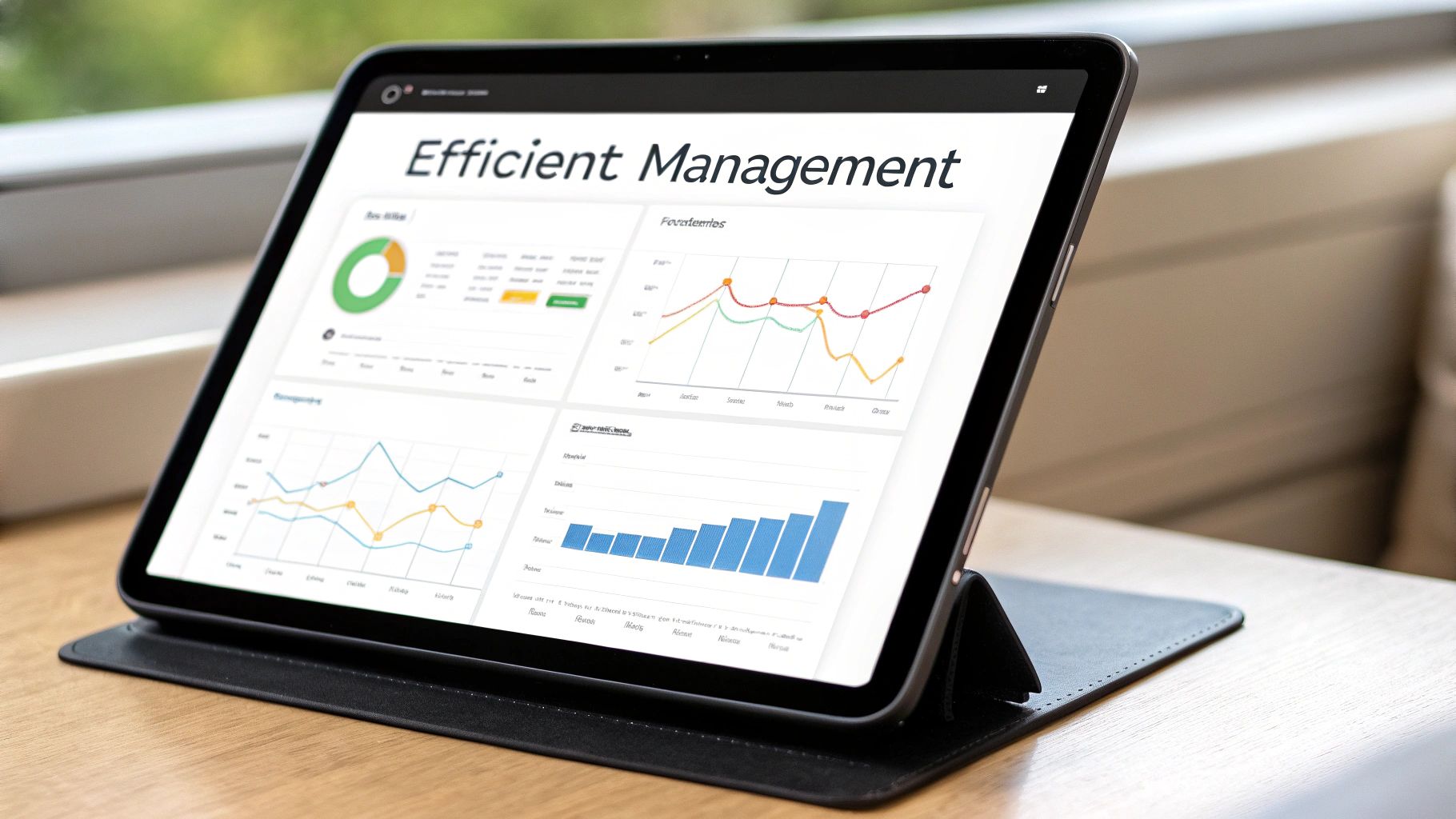Digital Transaction Management Software: The Ultimate Guide to Business Transformation
Understanding the Digital Transaction Revolution

Companies are quickly adopting digital transaction management (DTM) software to improve their business processes. These systems help convert paper-based tasks into digital formats, leading to major cost savings, better efficiency, and happier customers. Let's explore the key benefits and factors driving businesses to embrace digital transactions.
The Power of Streamlined Workflows
DTM software excels at simplifying business processes. By automating document handling tasks like creation, routing, approvals, and e-signatures, these systems significantly reduce manual work. This allows employees to focus on valuable activities like customer service and business growth instead of chasing signatures or managing paper files. The improved efficiency directly boosts productivity and profits.
Enhanced Security and Compliance
Security is a core strength of digital transaction platforms. These systems protect sensitive data through encryption and access controls throughout the entire transaction process. They also help companies follow industry rules by providing detailed audit trails and secure document storage. This builds trust while reducing risks.
Driving Forces Behind the Digital Shift
The DTM market is growing rapidly due to increasing demands for faster, more efficient transactions. Companies want to optimize operations and cut costs, and DTM software delivers clear solutions. Remote work and the rise of online transactions have also sped up adoption. The market size reached $14.61 billion in 2023 and is expected to grow to $116.14 billion by 2032, showing a 25.9% CAGR from 2025 to 2032. For more details, see: Digital Transaction Management Market Research
Overcoming Implementation Fears
Some companies hesitate to adopt DTM due to concerns about system integration complexity and potential business disruptions. However, many successful implementations show these fears can be managed through proper planning and change management. Working with proven vendors and investing in staff training leads to smooth transitions. Clear communication about the benefits helps gain employee support and ensures a successful shift to more efficient digital processes.
Mastering Cloud-Powered Transaction Management

More companies are adopting cloud technology to handle digital transactions and documents. Moving beyond basic document digitization, businesses are now using cloud platforms to build more efficient and adaptable transaction processes. This allows them to respond faster to business needs. You might be interested in: How to master AI-Driven Development.
Evaluating and Implementing Cloud-Based DTM Solutions
Picking the right digital transaction management software requires careful assessment. Companies must consider their specific transaction volumes, document types, and system integration needs. A small startup has different requirements compared to a large enterprise with complex workflows.
The software also needs room to grow. Your chosen solution should scale up smoothly as transaction volumes increase and business needs change. This helps protect your investment and supports long-term business growth.
Seamless Integration and Hybrid Environments
Many organizations worry about connecting cloud transaction software with their current systems. Modern solutions make this simple with strong integration features that keep data flowing smoothly between platforms. This helps maintain data consistency without disrupting operations.
Many companies now use both on-premise and cloud systems together. Cloud transaction software works well in these hybrid setups by providing one platform to manage transactions across both environments.
Maximizing the Benefits of Cloud Flexibility
Cloud technology gives businesses more options for managing their work. With cloud transaction software, teams can access and handle documents from any location with internet access. This supports remote work and helps teams collaborate across different locations.
Companies can also adapt quickly as market conditions change. They can scale resources up or down based on demand, ensuring good performance during busy periods. The shift to cloud services has expanded the digital transaction market significantly. According to recent data, 42.5% of EU enterprises used cloud computing in 2023, up 4.2% from 2021. Learn more at Key Trend Reshaping the Digital Transaction Management Market.
Real-World Success Stories
Many organizations have successfully moved to cloud transaction management. Their experiences show others what's possible with these solutions. These cases highlight concrete benefits like better efficiency, lower costs, and improved security. They demonstrate how cloud solutions solve real business challenges and deliver measurable results.
Global Leadership in Digital Transactions
Digital transactions have seen remarkable growth worldwide, with different regions taking distinct approaches. North America has established itself as a frontrunner, accounting for 34.3% of global digital transaction management in 2020. This stems from widespread adoption across business sectors and strong technical infrastructure. For more data on this trend, view the detailed market analysis.
Regional Growth and Innovation
Each region brings unique strengths and approaches to digital transactions based on their specific circumstances:
Asia-Pacific: The region shows impressive momentum through rising internet access and tech adoption. China and India are testing blockchain and AI to boost transaction security.
Europe: With strong data protection rules like GDPR, European nations focus heavily on security compliance in digital transactions.
African Nations: Mobile money services like M-Pesa have helped African countries bypass traditional banking limits, enabling digital transactions in areas with minimal infrastructure.
Cultural and Legal Influences
How organizations implement digital transaction systems depends greatly on local factors. Cultural acceptance of digital tools affects adoption speed, while regulations can either help or slow progress. For example, data protection laws often require specific security features in transaction software. Success in multiple regions requires careful attention to these local differences.
Success Strategies from Leading Companies
Key practices that drive success in digital transactions include:
Local Focus: Modify solutions to match regional needs and rules to build user confidence.
Education: Offer clear training to help staff and customers adapt to digital systems.
Growth Ready: Choose systems that can expand with your business into new markets.
Local Partners: Work with regional experts to understand markets and connect with existing systems.
These approaches help organizations build effective digital transaction systems that work well in different market conditions while promoting positive change and efficiency.
Building Fortress-Level Security and Compliance

In the online business world, strong security is essential for protecting sensitive data and transactions. As more business moves online, digital transaction management software helps create robust protection that keeps both companies and customers safe.
Understanding the Importance of Security Frameworks
A solid security framework serves as the foundation for reliable digital transaction systems. This framework must include key elements that ensure data integrity, confidentiality, and consistent access. Here are the critical components:
- Data Encryption: Think of encryption as a high-tech vault that makes sensitive information unreadable to unauthorized users. Strong encryption protects data both in storage and during transmission.
- Access Controls: These systems manage who can view specific information. Like security clearance levels, access controls ensure only authorized staff can see certain data.
- Two-Factor Authentication (2FA): Adding 2FA is like requiring both a key card and passcode - even if login details are stolen, accounts stay secure.
Implementing Multi-Layer Security
The most effective security uses multiple protective layers working together. Picture a medieval castle with walls, moats, and guard towers - each barrier adds vital protection.
- Regular Security Audits: Like inspecting castle defenses, routine audits find weak spots before they become problems. These checks ensure security stays strong over time.
- Intrusion Detection Systems: These tools act as watchful guards, monitoring for threats and raising alarms at the first sign of trouble. Quick detection helps minimize security issues.
- Vulnerability Scanning: Being proactive about finding weak points lets you fix them before attackers can exploit them. Regular scanning strengthens your overall security.
Addressing Compliance Requirements
Beyond internal security, digital transaction systems must meet industry regulations and privacy laws. Following compliance rules isn't optional - it's legally required. Quality transaction management software helps simplify meeting these requirements.
The need for secure, automated processes is driving major growth in digital transaction management, especially with more remote work. See the latest market data here. You may also be interested in: The Manifest recognizes Hyathi Technologies as a Top Cybersecurity Company.
Following standards like GDPR, HIPAA, and PCI DSS builds customer trust and provides a real business advantage. Strong security practices protect your reputation and help avoid legal issues. By making security and compliance top priorities, digital transaction software creates the foundation for safe, trustworthy business operations.
Transforming Your Organization Through Smart Implementation
Making the switch to digital transaction management requires a structured approach. Since this change affects your entire organization, thoughtful planning and execution are essential for success.
Developing Effective Training Programs
Good training is crucial for adopting new software successfully. Staff need clear guidance on both the technical aspects and the practical benefits in their daily work. Showing concrete examples, like how the software cuts down on manual data entry and creates more time for strategic work, helps build understanding and enthusiasm for the new tools.
Overcoming Resistance to Change
It's natural for some team members to hesitate when faced with new technology. The key is addressing concerns openly and showing how the software makes work easier and more efficient. Getting employees involved in the implementation process and acting on their input helps create buy-in. When people feel heard and see their suggestions put into action, they're more likely to embrace the change.
Creating a Culture of Digital Excellence
Implementing new software requires shifting mindsets across the organization. Highlight success stories and recognize early adopters who excel with the new tools. Share specific examples of how teams are working better and getting improved results. This positive reinforcement helps build momentum and encourages others to get on board. Take a look at our guide on Mastering Digital Transformation.
Measuring Progress and Maintaining Momentum
Track concrete results once the software is in place. Set clear key performance indicators (KPIs) like processing speed, error reduction, and customer satisfaction scores. Regular monitoring shows the real value being delivered and helps identify areas for improvement. Use this data to make smart adjustments and ensure the software keeps meeting business needs.
Addressing Common Implementation Challenges
Every implementation has its bumps in the road. Be ready for technical integration issues by having dedicated support staff or vendor resources available. Watch for signs of lagging user adoption and provide ongoing training and help resources. Taking a proactive approach to solving problems keeps the implementation on track and helps maximize the benefits of your digital transaction management software.
Maximizing ROI and Preparing for Future Innovation

Getting the most out of digital transaction management software requires careful planning and an eye on the future. While implementing this technology is an important first step, the real value comes from optimizing its use and adapting to new developments in the field.
Calculating and Optimizing ROI for Digital Transaction Management
When evaluating the return on investment for digital transaction management software, look beyond basic cost comparisons. Consider how automated processes free up employee time for higher-value work that drives revenue. Also account for savings from fewer errors and better compliance. Key factors to measure include:
- Cost Savings: Reduced paper, printing, storage and mailing expenses
- Increased Efficiency: Time saved through automated workflows
- Reduced Errors: Financial benefits of fewer mistakes
- Improved Compliance: Value of lower risk and avoiding penalties
- Enhanced Customer Satisfaction: Impact of faster service on retention
Tracking Key Performance Indicators (KPIs)
Clear metrics help demonstrate the impact of digital transaction management. These KPIs reveal how the system improves business operations:
- Transaction Completion Time: Duration from start to finish
- Document Processing Speed: Time to process and approve documents
- Error Rate: Number of mistakes in transactions
- Customer Satisfaction: User feedback on the digital experience
- Compliance Rate: Percentage meeting regulations
Emerging Trends and Future-Proofing Your Investment
The digital transaction landscape continues to advance. Stay current with these key developments:
- Artificial Intelligence (AI): Automation of tasks and improved analytics
- Blockchain Technology: Enhanced security and transaction transparency
- Mobile-First Approach: Optimizing for transactions on mobile devices
Understanding and incorporating these technologies helps protect your investment and maintains competitiveness.
Real-World Examples of Successful Implementations
Looking at how other organizations have successfully used digital transaction management provides practical insights. Study companies in your industry to learn effective strategies and avoid common pitfalls during your own implementation.
Hyathi Technologies provides AI-powered solutions to help businesses improve their digital transaction processes. Their tools enable faster, more secure, and efficient transaction management.